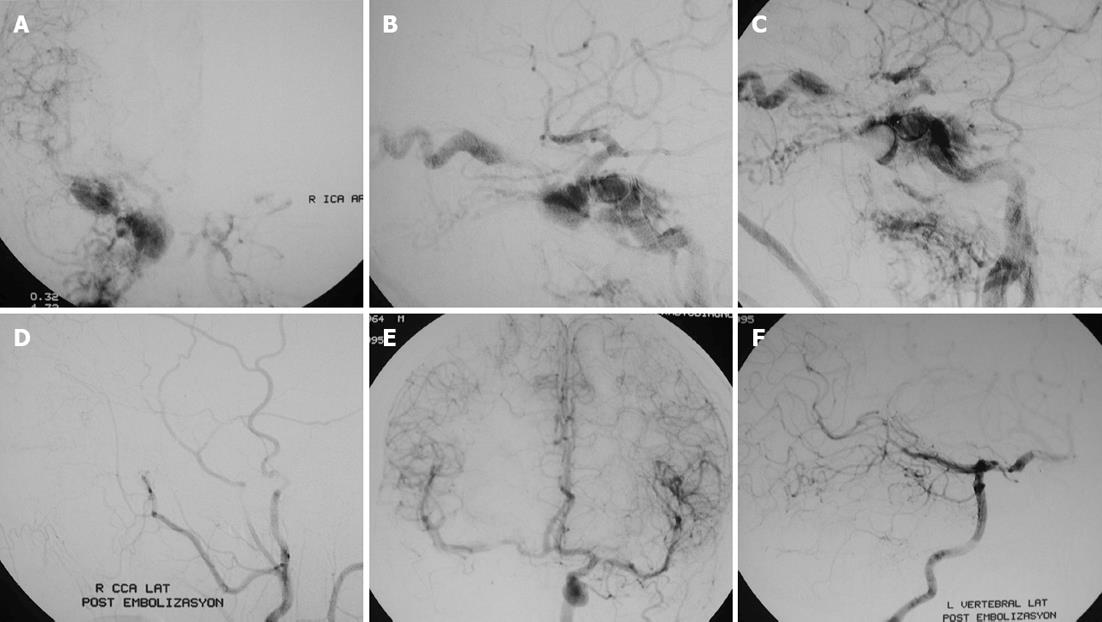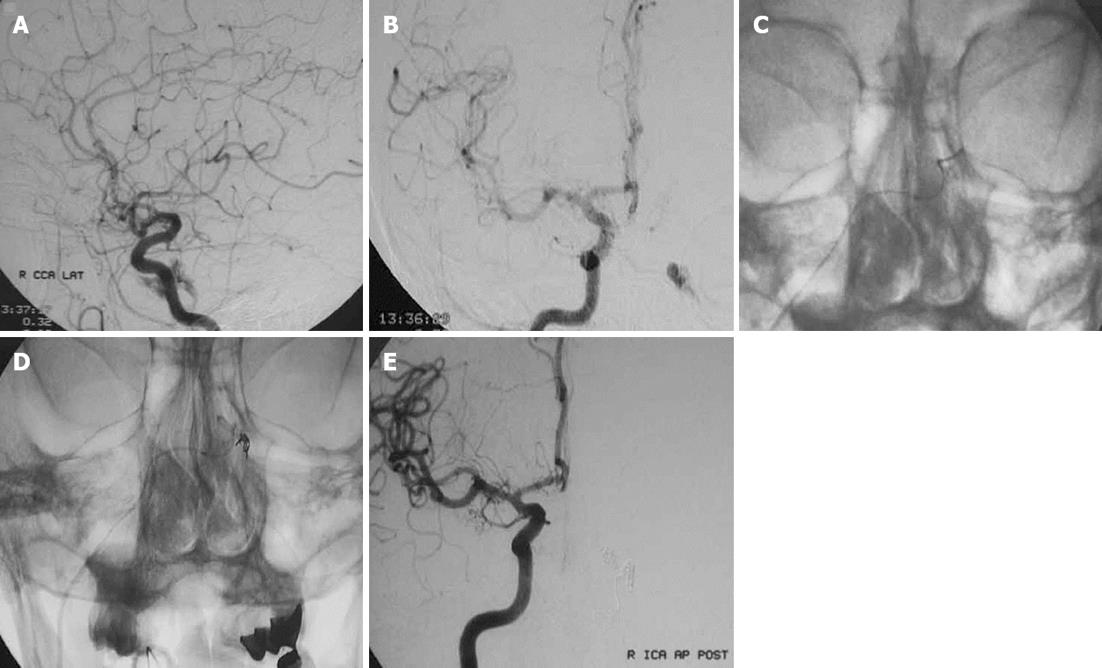Copyright
©2013 Baishideng Publishing Group Co.
World J Radiol. Apr 28, 2013; 5(4): 143-155
Published online Apr 28, 2013. doi: 10.4329/wjr.v5.i4.143
Published online Apr 28, 2013. doi: 10.4329/wjr.v5.i4.143
Figure 1 A thirty one-year-old man who was diagnosed with carotid cavernous sinus fistula which developed secondary to a motor vehicle accident.
A: Digital subtraction angiogram view of left internal carotid artery (ICA) revealed laceration in the anterior loop and associated direct carotid cavernous sinus fistula; B: Balloon detachment failed because of the site and small calibre of the fistula orifice. Coil embolization of the fistula was then performed with preservation of the ICA; C: Post-procedural left ICA injection showed lack of residual filling, preservation of parent artery and detached coils at the site of fistula.
Figure 2 A fifty two-year-old woman who presented with galactorrhea due to hypophyseal adenoma underwent transsphenoidal surgery.
During the operation internal carotid artery laceration and massive arterial hemorrhage occurred. A: T1 W C+ coronal magnetic resonance imaging view demonstrating hypointensity at the left hypophyseal region which was consistent with hypophyseal adenoma; B: Immediate defect source analysis revealed a defect at the anteromedial wall of right internal carotid artery (ICA) and associated carotid cavernous sinus fistula; C: Position of the stent-graft closing the orifice of the fistula; D: Postprocedural right ICA injection demonstrating complete obliteration of the fistula and concentric luminal stenosis at the petrous segment associated with mechanic vasospasm secondary to guide-wire and stent manipulation; E: Third month control angiography revealed regular parent artery contours, absence of recurrent fistula filling and intimal hyperplasia within the stent.
Figure 3 A thirty one-year-old male patient with right ophthalmoplegia following head trauma was found to have a direct carotid cavernous sinus fistula.
A, B: Frontal (A) and lateral (B) digital subtraction angiogram views of right internal carotid artery (ICA) demonstrating laceration of ICA, pseudoaneurysm in the cavernous ICA and direct carotid cavernous sinus fistula; C: After considering the presence of the pseudoaneurysm, two detachable balloons were positioned to occlude the parent artery; D: Right CCA digital subtraction angiogram after balloon occlusion of the ICA showing complete obliteration of the fistula; E, F: Posttreatment left ICA (E) and left vertebral artery (F) injections demonstrating reconstruction of the right ICA area.
Figure 4 A forty-year-old woman with chemosis of the left eye and diplopia was found to have a dural carotid cavernous sinus fistula.
A, B: Frontal (A) and lateral (B) injections of the right common carotid artery demonstrating left dural carotid cavernous sinus fistula with antegrade drainage; C: Access to the fistula site through the contralateral (right inferior petrous sinus) transvenous route and positioning of the microcatheter; D: Coil embolization within the microcather extending into the venous compartment of the fistula; E: Posttreatment frontal digital subtraction angiogram view of right internal carotid artery demonstrating obliteration of the fistula and lack of residual filling.
Figure 5 In extremely difficult cases of venous occlusion, stenosis, or marked tortuosity, access to the cavernous sinus can be provided by combined surgical and endovascular approaches.
A, B: Left external carotid artery lateral (A) and left internal carotid artery lateral (B) digital subtraction angiogram views of an uncovered dural carotid cavernous sinus fistula which has antegrade drainage; C: Posterior access to the fistula site was not feasible, so access was gained through the superior ophthalmic vein following surgical angular vein cut-down; D: Coil detachment through a microcatheter into the fistula site; E: Posttreatment left common carotid artery injection revealed lack of residual filling of the fistula.
- Citation: Korkmazer B, Kocak B, Tureci E, Islak C, Kocer N, Kizilkilic O. Endovascular treatment of carotid cavernous sinus fistula: A systematic review. World J Radiol 2013; 5(4): 143-155
- URL: https://www.wjgnet.com/1949-8470/full/v5/i4/143.htm
- DOI: https://dx.doi.org/10.4329/wjr.v5.i4.143













